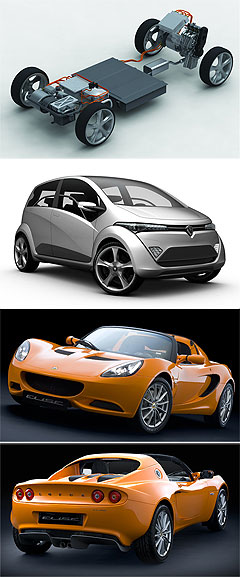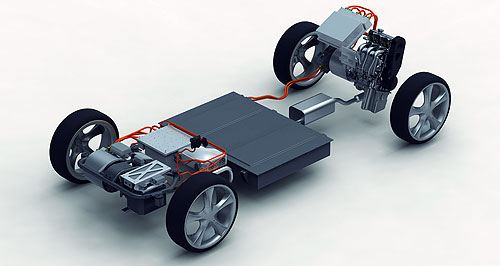Future models - Lotus - Evora - 414e HybridGeneva show: Lotus plugs in with 414E HybridWatts on: Lotus is going plug-in with a hybrid Evora at Geneva. Lotus demonstrates sports plug-in hybrid powertrain with Evora-based Geneva concept25 Feb 2010 By TERRY MARTIN LOTUS will unveil the Evora 414E Hybrid at the Geneva motor show next week, a high-performance concept with a sparkling new plug-in hybrid powertrain the British marque has developed for its lightweight sportscars. Integrated into the Evora coupe’s mid-engined rear-drive platform, the new propulsion system discards the Toyota-sourced 206kW/350Nm 3.5-litre 2GR-FE petrol V6 for a new drivetrain which includes an electric motor at each rear wheel – each providing 152kW of power and 400Nm of torque via an independent single-speed reduction transmission. According to Lotus, the twin rear motor design enables a higher level of vehicle dynamics, including torque vectoring, which as seen on the conventional-engined Porsche 911 Turbo provides inner rear wheel braking that can increase cornering speeds. In a similar vein to other plug-in hybrids such as the forthcoming Chevrolet/Holden Volt, a ‘Range Extender’ combustion engine – in this case, a 35kW 1.2-litre three-cylinder petrol unit – is also onboard to act primarily as a generator that recharges the vehicle’s centre-mounted 17kWh lithium polymer battery pack and extends the driving range to more than 483km (300 miles). Battery recharging can also take place from a conventional domestic mains supply via a socket behind the rear numberplate.  From top: Proton hybrid drivetrain, Giugiaro-designed Proton hybrid city-car concept and MY10 Lotus Elise. From top: Proton hybrid drivetrain, Giugiaro-designed Proton hybrid city-car concept and MY10 Lotus Elise.The petrol engine’s cylinder block, cylinder head and exhaust manifold are integrated in a single casting, which Lotus says reduces engine mass, assembly costs and package size, and also serves to improve emissions and engine durability. The lightweight (85kg) unit is also capable of running on biofuels. Interestingly, the Lotus Engineering-developed 1.2-litre ‘Range Extender’ will also make an appearance at Geneva in parent company Proton’s new Giugiaro-designed plug-in hybrid city car – in a front-mounted, front-wheel drive application. Lotus claims the 414E Hybrid can reach 97km/h (60mph) in less than four seconds and that for “everyday commuting journeys” it can manage up to 56km (35 miles) without intervention from the combustion engine. The driver can also select between Eco and Sports modes, with the latter simulating a seven-speed paddle shift transmission. The idea is to reduce the “psychological step” for people accustomed to high-performance cars, with the column-mounted paddle shift designed to be reminiscent of a dual-clutch transmission (despite it being a single-speed unit). A synthetised engine sound also changes frequency with each virtual gear selection, and Lotus says the drive torque is modulated “to simulate a physical feeling of a gearshift jolt”. The drivetrain is prominently displayed under a new glass engine cover/roof design, while the concept car also incorporates “HALOsonic Internal and External Electric Sound Synthesis” technologies that are said to provide sound contouring within the cabin and improved pedestrian safety outside the vehicle. These “noise solutions” include the aforementioned emotive engine sound – with a choice between four rorty notes (including conventional V6 and V12 and a “futuristic” propulsion sound) – and other sounds that provide a warning to pedestrians via front and rear speakers. “Innovation has always been at the heart of Lotus and is needed now more than ever,” said Lotus Engineering director Robert Hentschel. “The Evora 414E Hybrid is the perfect demonstration of Lotus Engineering’s core competencies: lightweight architectures, efficient performance, electrical and electronics integration and driving dynamics. “The technology demonstrator represents an encapsulation of the advanced technologies that Lotus Engineering continues to develop to overcome the current environmental challenges facing the automotive industry and showcases the future direction that the sector is taking and why Lotus Engineering is perfectly placed to lead the technological development in this area.” Not stopping there, Lotus will also use the Geneva show to stage the world premiere of its updated 2011 Model Year Elise, which takes on a more Evora-like design and, most importantly, includes the option of a 1.6-litre engine for the first time. Slotting into the range below the 141kW 1.8-litre Elise R and the 162kW 1.8 supercharged Elise SC as the new entry-level model – and replacing the current baseline 1.8-litre S – the 1.6 uses a Toyota-sourced 100kW/160Nm 1598cc 1ZR-FAE engine with Valvematic and Dual VVT-i technology. It combines with a new six-speed close-ratio manual gearbox and, compared with the current (five-speed manual) 1.8 S, offers a 23 per cent improvement in fuel economy (down to 6.1L/100km) and 13 per cent fewer CO2 emissions (to 155g/km) – claimed by Lotus to be the lowest CO2 performance for any petrol-powered high-performance sportscar in the world. Tipping the scales at just 876kg, the new entry Elise can reach 100km/h in 6.7 seconds and has a maximum speed of 200km/h. Revised styling common to the entire range includes a new front “clamshell”, a distinctive new “twin-spine” engine cover, revised front and rear bumpers, a more aggressive diffuser, new integrated headlight units (including LED daytime running lights and LED indicators), and new wheel designs, including optional forged alloy wheels. The changes have also created a four per cent reduction in the Elise’s drag coefficient, with the improved aerodynamics resulting in better fuel economy and lower emissions across the range. The R and SC, for example, now emit 196g/km and 199g/km of CO2 respectively.  Read more15th of February 2010  Geneva show: First Proton hybrid emergesMalaysian car-maker and Italian design house join forces to produce Proton hybridAll future models Alfa Romeo Alfa Romeo Abarth Abarth Audi Audi Aston Martin Aston Martin BMW BMW Bentley Bentley Chrysler Chrysler Chevrolet Chevrolet Dodge Dodge Citroen Citroen Ferrari Ferrari DS DS Ford Ford Fiat Fiat FPV FPV Foton Foton Haval Haval Great Wall Great Wall Honda Honda Holden Holden Hyundai Hyundai HSV HSV Isuzu Isuzu Infiniti Infiniti Jeep Jeep Jaguar Jaguar Lamborghini Lamborghini Kia Kia Lexus Lexus Land Rover Land Rover Mazda Mazda Maserati Maserati Mercedes-Benz Mercedes-Benz McLaren McLaren Mini Mini Nissan Nissan Mitsubishi Mitsubishi Peugeot Peugeot Opel Opel Proton Proton Porsche Porsche Renault Renault Ram Ram Saab Saab Rolls-Royce Rolls-Royce Smart Smart Skoda Skoda Subaru Subaru SsangYong SsangYong Tesla Tesla Suzuki Suzuki Toyota Toyota Volvo VolvoEvora pricingMotor industry news |
Click to shareLotus modelsResearch Lotus All future models Alfa Romeo Alfa Romeo Abarth Abarth Audi Audi Aston Martin Aston Martin BMW BMW Bentley Bentley Chrysler Chrysler Chevrolet Chevrolet Dodge Dodge Citroen Citroen Ferrari Ferrari DS DS Ford Ford Fiat Fiat FPV FPV Foton Foton Haval Haval Great Wall Great Wall Honda Honda Holden Holden Hyundai Hyundai HSV HSV Isuzu Isuzu Infiniti Infiniti Jeep Jeep Jaguar Jaguar Lamborghini Lamborghini Kia Kia Lexus Lexus Land Rover Land Rover Mazda Mazda Maserati Maserati Mercedes-Benz Mercedes-Benz McLaren McLaren Mini Mini Nissan Nissan Mitsubishi Mitsubishi Peugeot Peugeot Opel Opel Proton Proton Porsche Porsche Renault Renault Ram Ram Saab Saab Rolls-Royce Rolls-Royce Smart Smart Skoda Skoda Subaru Subaru SsangYong SsangYong Tesla Tesla Suzuki Suzuki Toyota Toyota Volvo VolvoEvora pricingMotor industry news |
















Facebook Twitter Instagram